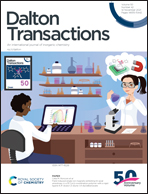Design of trimetallic sulfide hollow nanocages from metal–organic frameworks as electrode materials for supercapacitors†
Abstract
Transition metal sulfides (TMSs) are the most used electrode materials for supercapacitors (SCs). However, they still suffer from unsatisfactory electrochemical properties. Designing a hollow mixed TMS nanostructure with a well-defined chemical composition and shape is an effective strategy to tackle this issue, yet remains challenging. Herein, using a bimetallic zeolitic imidazolate framework (Zn–Co-ZIF) with various Zn/Co ratios as the template, a series of trimetallic sulfide (Ni–Zn–Co–S) hollow nanocages were successfully prepared by sequential nickel nitrate etching, co-precipitation and vulcanization. As an electrode material for a three-electrode SC in an aqueous alkaline electrolyte, the Ni–Zn–Co–S-0.25 electrode achieves an ultra-high specific capacitance of 1930.9 at 1 A g−1 with a good rate performance (64.5% at 10 A g−1). In order to further prove the advantage of the as-prepared Ni–Zn–Co–S-0.25 material, it was assembled into an asymmetric energy storage device using an activated carbon (AC) anode. The Ni–Zn–Co–S-0.25//AC cell exhibits an outstanding energy storage capability (32.8 W h kg−1 at 864.8 W kg−1) with a splendid cyclic life (retaining ∼92.2% of the initial capacitance after 10 000 cycles). The excellent electrochemical performance of Ni–Zn–Co–S-0.25 is ascribed to the merits of the trimetallic sulfide hollow nanocage i.e., good electronic conductivity, a large active surface area, fast charge transfer, rich redox reactions and the synergic effect of different metal ions.



 Please wait while we load your content...
Please wait while we load your content...